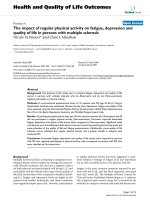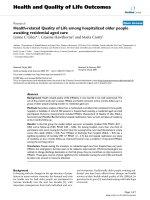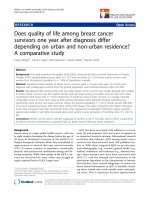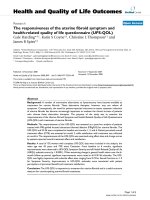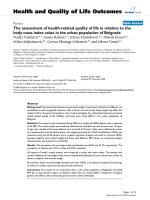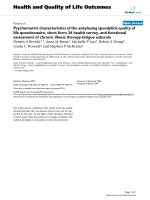báo cáo hóa học: " Health-related Quality of Life among hospitalized older people awaiting residential aged care" pot
Bạn đang xem bản rút gọn của tài liệu. Xem và tải ngay bản đầy đủ của tài liệu tại đây (273.59 KB, 7 trang )
BioMed Central
Page 1 of 7
(page number not for citation purposes)
Health and Quality of Life Outcomes
Open Access
Research
Health-related Quality of Life among hospitalized older people
awaiting residential aged care
Lynne C Giles*
1
, Graeme Hawthorne
2
and Maria Crotty
1
Address:
1
Department of Rehabilitation and Aged Care, Flinders University, GPO Box 2100, Adelaide, South Australia 5001 and
2
Department of
Psychiatry, Faculty of Medicine, Dentistry and Health Sciences, The University of Melbourne, Parkville, Melbourne, Victoria 3050, Australia
Email: Lynne C Giles* - ; Graeme Hawthorne - ;
Maria Crotty -
* Corresponding author
Abstract
Background: Health related quality of life (HRQoL) in very late life is not well understood. The
aim of the present study was to assess HRQoL and health outcomes at four months follow-up in a
group of older people awaiting transfer to residential aged care.
Methods: Secondary analysis of data from a randomized controlled trial conducted in three public
hospitals in Adelaide. A total of 320 patients in hospital beds awaiting a residential aged care bed
participated. Outcome measurements included HRQoL (Assessment of Quality of Life; AQoL),
functional level (Modified Barthel Index), hospital readmission rates, survival, and place of residence
at four months follow-up.
Results: In this frail group the median AQoL was poor at baseline (median 0.02; 95%CI -0.01 –
0.04) and at follow-up (0.05; 95%CI 0.03 – 0.06). On leaving hospital, more than one third of
participants who were moving for the first time into nursing home care rated themselves in a state
worse than death (AQoL ≤ 0.0). Poor HRQoL at discharge from hospital (AQoL ≤ 0.0) was a
significant predictor of mortality (HR 1.7; 95%CI 1.2 – 2.7), but not hospital readmission nor place
of residence at four months follow-up. Improved function was a predictor of improved HRQoL
among the surviving cohort.
Conclusion: People making the transition to residential aged care from hospital have very poor
HRQoL, but small gains in function seem to be related to improvement. While functional gains are
unlikely to change discharge destination in this frail group, they can contribute to improvements in
HRQoL. These gains may be of great significance for individuals nearing the end of life and should
be taken into account in resource allocation.
Background
In keeping with the changes in the age structure of popu-
lations in many western countries, the demand and costs
for health care for frail older people are anticipated to
increase markedly over the next few decades [1], with
important consequences from both individual and soci-
etal viewpoints. Traditionally older people entering resi-
dential care have been offered fewer therapy and health
services as their health-related quality of life (HRQoL) is
perceived to be poor [2] and deteriorating with little hope
of reversal.
Published: 26 July 2009
Health and Quality of Life Outcomes 2009, 7:71 doi:10.1186/1477-7525-7-71
Received: 26 February 2009
Accepted: 26 July 2009
This article is available from: />© 2009 Giles et al; licensee BioMed Central Ltd.
This is an Open Access article distributed under the terms of the Creative Commons Attribution License ( />),
which permits unrestricted use, distribution, and reproduction in any medium, provided the original work is properly cited.
Health and Quality of Life Outcomes 2009, 7:71 />Page 2 of 7
(page number not for citation purposes)
The HRQoL among older people has been reported in a
variety of samples. However, the majority of studies have
been based on community-dwelling older people [3-6] or
on groups of people with particular health conditions [7-
13]. There is a paucity of studies that have examined
HRQoL in residential aged care [14], and none have
reported HRQoL among people who are waiting for, or
who have entered, residential aged care.
Older people caught at the interface of hospital and aged
care services have historically been stigmatised as 'bed
blockers' and faced lengthy waits for appropriate care
[15]. In Australia, the Transition Care Program was intro-
duced in 2005 to facilitate the transitions of older people
between the acute and aged care systems. In this program,
transition care is provided at the conclusion of an inpa-
tient hospital episode and involves up to 12 weeks of sup-
port and active management. It is designed to allow older
people additional time and assistance to complete the
restorative process, optimise functional capacity and
finalise longer term living arrangements [16].
As part of a randomized controlled trial evaluating a tran-
sitional care facility [15], we assessed the HRQoL of older
people awaiting first-time transfer to residential aged care
using the Assessment of Quality of Life (AQoL) measure
[17-19]. We also considered the relationship between
HRQoL and survival, hospital usage, residence status and
function over a four-month follow-up period.
Methods
Participants
Participants were those who consented to be part of a trial
evaluating a transitional care facility for older hospitalised
patients waiting for a residential aged care bed. The study
has been reported in detail elsewhere [15]. In brief, partic-
ipants were recruited from the three public hospitals in
the southern region of Adelaide, South Australia. Partici-
pants were recruited while they were in hospital and writ-
ten consent was gained from either the participant or their
carer. Participants were then randomized in a 2:1 ratio to
either transfer to the transitional care facility or to receive
usual care in hospital while waiting for entry to a residen-
tial care facility. Ethical approval for the study was gained
from the relevant committees of the three participating
hospitals.
Measures
Questionnaires concerning function (modified Barthel
Index [20]) and HRQoL (measured with the AQoL [18])
were completed at baseline and four-month follow-up.
Proxy respondents completed the questionnaires when
participants were unable to self-respond to the question-
naires.
The AQoL [17,18] was used to assess HRQoL. In the
AQoL, a utility score is derived from scores on four dimen-
sions measuring Independent living, Social relationships,
Physical senses and Psychological well-being. The AQoL is
scored on a life-death scale, where the lowest possible
value, -0.04, represents states that are valued worse than
death, 0.00 represents death-equivalent states and the
highest value, 1.00, represents the best possible life state.
The AQoL has been extensively validated across clinical
and community settings [18]. Australian population
norms show a mean AQoL of 0.75 (95%CI:0.72–0.78) for
those aged 70–79 years and 0.66 (95%CI: 0.60–0.72) for
those aged 80 years or more [19]. In the present study and
irrespective of whether completed by self or proxy
respondent, the reliability of the AQoL for study partici-
pants was Cronbach's α = 0.56, lower than that published
elsewhere [19].
The modified Barthel Index [20] assesses function using ten
items that cover mobility and self-care domains. The ten
items are weighted and summed to give a modified Bar-
thel index score between 0 and 100. A score of 0 indicates
total dependence in activities of daily living, while 100
indicates complete independence in the mobility and self-
care domains. The reliability of the modified Barthel
Index in the present study was high (Cronbach's α =
0.96).
Participant status at four months (living in permanent
care, living at home, in hospital, other place or residence,
dead) and hospital usage in the four month follow-up
period were also assessed. Date of death was recorded for
decedents and verified from case notes and obituary list-
ings.
Data analysis
Because the distributions of the baseline and follow-up
AQoL scores were skewed, non-parametric statistical tests
were used. The mean was used to impute missing AQoL
values (n = 2 at baseline and n = 1 survivor at follow-up).
A Wilcoxon signed-rank test was used to compare baseline
and follow-up AQoL utility scores. This analysis was
repeated with follow-up AQoL scores of 0.0 (death-equiv-
alent state) imputed for the participants who died during
the follow-up period. AQoL scores at baseline for partici-
pants who self-consented versus those for whom proxy
consent was given were compared using a Mann-Whitney
U test. The minimal important difference of 0.06 [19] for
the AQoL was used in the interpretation of results.
AQoL scores were dichotomised (≤ 0.0 vs >0.0) and Cox
proportional hazards regression [21] was used to assess
the effect of baseline AQoL on mortality. The effect of
baseline AQoL ≤ 0.0 upon hospital utilisation and place
of residence during follow-up was assessed using binary
Health and Quality of Life Outcomes 2009, 7:71 />Page 3 of 7
(page number not for citation purposes)
and multinomial logistic regression models respectively.
A linear regression model was fitted to assess the effect of
change in function upon change in AQoL among the sur-
viving cohort. Age and gender were included as covariates
in this model. All analyses were performed using SPSS,
version 12.0 [22]. A significance level of α = 0.05 was used
in the analyses.
Results
A total of 320 participants were enrolled in the study.
Three participants subsequently withdrew, and thus 317
participants completed baseline assessments, while 230
participants survived to four month follow-up and com-
pleted assessments at the follow-up point. As described in
Crotty et al. [15], the average age of participants was 82.9
(SD 7.9) years. Half of the participants were men, as one
of the participating hospitals provided prioritized health
services for war veterans. The participants were frail, with
a mean modified Barthel index score of 47.3 (SD 30.4) at
baseline. Almost 30% of the participants were admitted to
hospital with musculoskeletal problems (falls, fractures
and soft tissue injuries). There were no differences in base-
line measures between the participants who were allo-
cated to the transitional care facility and the participants
who were allocated to receive usual care. Proxy respond-
ents completed the questionnaires for the majority (n =
250; 79%) of the participants.
HRQoL among all participants
The median AQoL utility scores indicated extremely poor
HRQoL at baseline (median 0.02; 95%CI 0.02 – 0.04)
and at follow-up (0.05; 95%CI 0.03 – 0.06). Figure 1
demonstrates that all
of the baseline and follow-up AQoL
scores fell below the comparable mean norm score of 0.73
for Australians aged 70 years or more [19]. Furthermore,
34% of all participants rated themselves as in a state worse
than death at baseline, and 81% of the sample rated them-
selves at or near death-equivalent health-related quality of
life (AQoL < 0.10).
As shown in Table 1, the independent living scale had the
lowest baseline and follow-up median scores, suggesting
poorest HRQoL in this domain. Social relationships
scores were intermediate. Physical sense and psychologi-
cal well-being had the highest median utility scores at
both time points, contributing the least disutility to the
overall AQoL score.
A sensitivity analysis with death-equivalent HRQoL equal
to 0.0 imputed for the 87 decedents showed no significant
difference between AQoL at baseline and follow-up
(median improvement 0.01; 95%CI 0.00–0.01; P =
0.170).
Distribution of Assessment of Quality of Life scoresFigure 1
Distribution of Assessment of Quality of Life scores
Health and Quality of Life Outcomes 2009, 7:71 />Page 4 of 7
(page number not for citation purposes)
As shown in Figure 2, baseline AQoL ≤ 0.0 was a signifi-
cant predictor of mortality at four months follow-up (age
and gender adjusted HR 1.7; 95%CI 1.2 – 2.7). A total of
103 participants (33%) presented or were admitted to
hospital in the follow-up period.
HRQoL among surviving participants
Amongst the subset of 230 participants who survived the
four month follow-up period, the proportion who rated
themselves in a state worse than death at baseline was
similar (30%) to the full sample, as was the proportion
who reported an AQoL < 0.10 (77%). At four month fol-
low-up, 20% of the surviving participants rated them-
selves as in a state worth than death, and 71% reported
AQoL utility scores of <0.10. Among the 230 surviving
participants, there was a small increase in follow-up AQoL
score compared with baseline AQoL (median improve-
ment 0.01; 95%CI 0.00 – 0.03; P = 0.003). However, the
effect of baseline AQoL ≤ 0.0 on hospital utilisation dur-
ing follow-up (age and gender adjusted OR 0.8; 95%CI
0.5 – 1.3) was not significant. Baseline AQoL ≤ 0.0 was
not a significant predictor of place of residence among the
survivors (age and gender adjusted OR
home vs res care
0.6;
95%CI 0.2–1.7; age and gender adjusted OR
other vs res
care
0.8; 95%CI 0.4–1.7).
Improved function, as measured by the change in the
modified Barthel Index, was a statistically significant pre-
dictor of improved AQoL among the surviving cohort. A
multiple linear regression model showed that every 10
unit change in the modified Barthel index predicted a 0.03
change (SD = 0.003) in the AQoL score.
HRQoL among proxy and nonproxy respondents
Participants for whom the questionnaires were completed
by proxy (n = 250) had significantly lower median AQoL
scores at baseline (0.01; 95%CI 0.00 – 0.02) than for
those 67 participants who self-completed the AQoL (0.07;
95%CI 0.05 – 0.09; P < 0.001). A similar result held at fol-
low-up (proxy-completion median 0.03; 95%CI 0.02 –
0.05; self-completion 0.09; 0.08 – 0.13; P < 0.001).
Among the self-completers there was a small, but not sta-
tistically significant, increase in follow-up AQoL score
from baseline (median improvement 0.05; 95%CI -0.01 –
0.09; P = 0.093).
HRQoL among usual care recipients
Among the subset of participants who received usual care
(n = 105), the baseline and follow-up median AQoL
scores were again very low (baseline 0.02; 95%CI 0.00 –
0.04; follow-up 0.08; 95%CI 0.04 – 0.11). The increase in
AQoL score at follow-up from baseline was modest but
statistically significant (median improvement 0.03;
95%CI 0.01 – 0.06; P = 0.001).
Conclusion
Hospitalized patients waiting for entry to residential care
were shown in this study to have very poor HRQoL at
both baseline and follow-up. A death-equivalent or worse
than death-equivalent AQoL at baseline was a significant
predictor of mortality over the ensuing four months of fol-
low-up. The study also demonstrated that an improve-
ment in function predicted an improvement in quality of
life over the follow-up period.
There was a small but statistically significant improve-
ment in AQoL utility from baseline to follow-up among
Table 1: AQoL scale summary statistics
Variable Mean SD 95%CI Median Q1
†
Q3
‡
Baseline (n = 317)
AQoL utility 0.06 0.10 0.05 – 0.07 0.02 -0.01 0.08
Independent Living 0.09 0.14 0.07 – 0.10 0.00 0.00 0.09
Social relationships 0.48 0.32 0.45 – 0.52 0.31 0.25 0.79
Physical sense 0.76 0.23 0.73 – 0.78 0.84 0.63 0.94
Psychological well-being 0.78 0.21 0.76 – 0.81 0.85 0.67 0.93
Follow-up (n = 230)
AQoL utility 0.09 0.13 0.07 – 0.11 0.05 0.00 0.13
Independent Living 0.11 0.17 0.09 – 0.14 0.00 0.00 0.24
Social relationships 0.55 0.30 0.51 – 0.59 0.69 0.27 0.80
Physical sense 0.79 0.16 0.77 – 0.81 0.82 0.75 0.88
Psychological well-being 0.86 0.15 0.84 – 0.88 0.90 0.83 0.93
Imputed follow-up (n = 317)*
AQoL utility 0.06 0.11 0.05 – 0.08 0.01 0.00 0.08
* AQoL of 0.0 imputed for 87 decedents at follow-up
†, ‡ – 25th and 75th percentiles respectively
Health and Quality of Life Outcomes 2009, 7:71 />Page 5 of 7
(page number not for citation purposes)
the surviving cohort. However, a sensitivity analysis in
which a death-equivalent AQoL of 0.0 was imputed dem-
onstrated no significant difference in AQoL scores
between the two time points. Slight decreases in HRQoL
measured by the EQ-5D at six month follow-up were
recently reported in a trial of home based medication
review post-hospitalisation for older people [23]. Thus
while improvement in HRQoL is possible, any such gains
without a very targeted approach are likely to be negligi-
ble.
The positive relationship between change in function and
change in AQoL among the study participants demon-
strates that improvements in function can improve
HRQoL, and conversely declines in function can impact
negatively on HRQoL. Sturm similarly reported a strong
correlation between the Barthel index and AQoL three
months post stroke [13]. In hospitals once a decision is
made that a patient is moving into residential care, reha-
bilitation and therapy services are frequently withdrawn.
The findings in the present study suggests that if rehabili-
tation services set realistic goals for functional improve-
ments, then gains in function can lead to small
improvements in HRQoL for very frail older people at the
beginning of their stay in residential aged care.
From a health economic perspective, it could be argued
that if the HRQoL among people waiting for first-time
transfer to residential care is virtually equivalent to death,
there is little point in intervening with health care pro-
grams that may have little health benefit and that drain
economic resources from other more cost-effective inter-
ventions. Although this argument fails the rule of rescue
which asserts that "it is the duty of society to assure equi-
table access to an adequate level of care for all" [24], it is
consistent with the long history, starting with Plato, of
those who have argued against the prolongation of the act
of dying and who, more recently, have explored the role
of clinicians in using societal resources to assist this pro-
longation. This dilemma – between the quality of life and
the quantity of life – was first raised in the quality of life
medical literature by Long in the context of the appropri-
ate allocation of resources to those in extremis [25].
Although Long argued for an ethical and humane solution
to this dilemma, more recently programs have focussed
on the political imperative to provide care whilst reducing
costs [2]. The results of this study suggest equivocal find-
Survival function for participants with baseline AQoL≤0.0 versus >0.0Figure 2
Survival function for participants with baseline AQoL≤0.0 versus >0.0
Health and Quality of Life Outcomes 2009, 7:71 />Page 6 of 7
(page number not for citation purposes)
ings and that inflexible philosophical positions regarding
the cessation or prolongation of care may not necessarily
apply to individuals.
This extremely frail group of older people was quite heter-
ogeneous. One third of the study sample had extremely
poor HRQoL at baseline and there was a high mortality
rate in the four month follow-up period amongst these
participants. However, 19% of the sample did not have
this very poor HRQoL at baseline (ie AQoL score > 0.1),
and gains in HRQoL were apparent at follow-up among
the survivors.
There are several caveats that must be borne in mind when
interpreting the results reported here. First, the proxy-
reported HRQoL scores were significantly lower than the
self-reported scores. This finding is consistent with the lit-
erature, and is a potential threat to the study findings.
Where self-report and proxy utility scores have been com-
pared, the self-reported scores are generally higher than
those of the proxies [26,27]. The implication is that self-
respondents rate their HRQoL higher than do external
observers, possibly due to adaptation or because proxies
may be either unaware of all aspects of self-respondents'
lives or may focus on the negative aspects of a person's life
[28]. There is, generally, highest agreement between self
and proxy assessments of more objective measures (e.g.
mobility) and greater discrepancy in the subjective areas
of life (e.g. social relationships) [29], although not all
studies have reported this [26,27]. Finally, while the sam-
pling frame in the present study represented the popula-
tion of hospital patients awaiting residential aged care, the
generalisability of our findings to other localities with a
different climate of health and aged care service provision
remains unknown.
The difficulty posed in studies of frail older persons is in
judging when proxy reports should be used. Self-report
assumes that the individual has the necessary insight into
his or her own life to be able to provide meaningful
assessments. In the present study, the capacity to self-com-
plete the study questionnaires was ascertained at baseline
when consent was granted either by the participant or
their proxy. Although we acknowledge the limitations of
mixing proxy with self-reported responses, on balance we
adopted the position that it was better to include proxy
reports for those unable to self-complete our question-
naire than to exclude them from the study altogether,
which would lead to a biased sample.
Second, because of the high mortality rate in the study
sample, we were limited to a reasonably short follow-up
period. Another measure of AQoL at 12 months would
give further insight as to whether improvements in func-
tion can improve HRQoL and/or survival time. To mini-
mize respondent burden a very constrained number of
outcome measures were used. Additional outcome meas-
ures, including an objective assessment of function such
as the Timed-Up-and-Go [30], would have helped to fur-
ther elucidate the relationship between function and
HRQoL. Finally, questionnaire based outcome assess-
ment may not fully reflect each individual's HRQoL and
qualitative interviews may have revealed "response shift"
where a person re-evaluates themselves after an interven-
tion as better or worse than at the beginning [31]. The
effects of such changes following hospitalization in frail
older people have not been explored and may be impor-
tant in augmenting our understanding of this group.
There are two main policy implications from the present
study, subject to replication of the study findings in other
studies. First, the findings suggest that whilst the patient is
in hospital planned rehabilitation and therapy care
should be continued in the hospital setting. Second, the
results suggest the need for a high level of coordination of
care during the transition period from hospital to residen-
tial care. The Transition Care Program [16,32] recently
introduced as a joint initiative of the federal and state Aus-
tralian governments may offer improved coordination of
the move from hospital to residential care, as may suba-
cute hospital geriatric assessment and rehabilitation serv-
ices [33]. The evidence base for the latter's efficacy in
improving patients' functional status and reducing hospi-
tal discharge rates to residential care, along with the uncer-
tainty that out-of-hospital programs offer an effective
alternative, has led to a recent call to prioritise redressing
the inadequate provision of these services in some regions
ahead of Transition Care Programs [34].
The denial of rehabilitation to elderly people from nurs-
ing homes (the "lost tribe") has been described as inap-
propriate [2]. Policy makers and clinicians need to
consider the implications of this study for health resource
allocation, and recognize that small improvements in
HRQoL may be of great significance for individuals near-
ing the end of life.
List of abbreviations
HRQoL: Health related Quality of Life; AQoL: Assessment
of Quality of Lifel; CI: Confidence Interval; OR: Odds
Ratio
Competing interests
The authors declare that they have no competing interests.
Authors' contributions
LG participated in study design and coordination, per-
formed the statistical analyses and drafted the manuscript.
GH participated in the statistical analyses and helped to
draft the manuscript. MC conceived of the study, partici-
Publish with BioMed Central and every
scientist can read your work free of charge
"BioMed Central will be the most significant development for
disseminating the results of biomedical research in our lifetime."
Sir Paul Nurse, Cancer Research UK
Your research papers will be:
available free of charge to the entire biomedical community
peer reviewed and published immediately upon acceptance
cited in PubMed and archived on PubMed Central
yours — you keep the copyright
Submit your manuscript here:
/>BioMedcentral
Health and Quality of Life Outcomes 2009, 7:71 />Page 7 of 7
(page number not for citation purposes)
pated in its design and coordination and helped to draft
the manuscript. All authors read and approved the final
manuscript.
Acknowledgements
We wish to thank the participants and their families for their involvement
in this study. We also wish to acknowledge the support of Aged Care and
Housing (ACH) Group, Michael Szwarcbord, deputy chief executive officer
of Flinders Medical Centre, and Brendan Hewitt, director of planning and
corporate services, Repatriation General Hospital. Funding for this study
came from an NHMRC Health Services Research Program Grant 402791 –
"Transition care: innovation and evidence", the South Australian Depart-
ment of Health and the Australian Government Department of Health and
Ageing (National Demonstration Hospital Program Phase 4).
References
1. Madge A: Long-term aged care: Expenditure trends and pro-
jections. Canberra 2000.
2. Stott DJ, Langhorne P, Knight PV: Multidisciplinary care for eld-
erly people in the community. Lancet 2008, 371:699-700.
3. Osborne RH, Hawthorne G, Lew EA, Gray LC: Quality of life
assessment in the community-dwelling elderly: validation of
the Assessment of Quality of Life (AQoL) Instrument and
comparison with the SF-36. Journal of Clinical Epidemiology 2003,
56:138-47.
4. Power M, Quinn K, Schmidt S: Development of the WHOQoL-
OLD module. Quality of Life Research 2005, 10:2097-104.
5. Walters SJ, Munro JF, Brazier JE: Using the SF-36 with older
adults: a cross-sectional community-based survey. Age and
Ageing 2001, 30:337-43.
6. Holland R, Smith RD, Harvey I, Swift L, Lenaghan E: Assessing qual-
ity of life in the elderly: a direct comparison of the EQ-5D
and AQoL. Health Economics 2004, 13:793-805.
7. Dugan E, Cohen SJ, Robinson D, Anderson R, Preisser J, Suggs P, et
al.: The quality of life of older adults with urinary inconti-
nence: determining generic and condition-specific predic-
tors. Quality of Life Research 1998, 7:337-44.
8. Logsdon RG, Gibbons LE, McCurry SM, Teri L: Assessing quality of
life in older adults with cognitive impairment. Psychosomatic
Medicine 2002, 64:510-9.
9. Naumann VJ, Byrne GJA: WHQoL-Bref as a measure of quality
of life in older patients with depression. International Psychoger-
iatrics 2004, 16:159-73.
10. Schrag A, Jahanshahi M, Quinn N: How does Parkinson's disease
affect quality of life? A comparison with quality of life in the
general population. Moving Disorders 2000, 15:1112-8.
11. Francis HW, Chee N, Yeagle J, Cheng A, Niparko JK: Impact of
cochlear implants on the functional health status of older
adults. Laryngoscope 2002, 112(8 Pt 1):1482-8.
12. Harris A, Gospodarevskaya E, Callaghan J, Story I: The cost effec-
tiveness of a pharmacist reviewing medication among the
elderly in the community. Australasian Journal on Ageing 2001,
20:179-86.
13. Sturm JW, Osborne RH, Dewey HM, Donnan GA, Macdonell RAL,
Thrift AG: Brief comprehensive quality of life assessment
after stroke: The Assessment of Quality of Life instrument in
the North East Melbourne Stroke Incident Study (NEME-
SIS). Stroke 2002, 33:2888-94.
14. Kane RA, Kling KC, Bershadsky B, Kane RL, Giles K, Degenholtz HB,
et al.: Quality of life measures for nursing home residents.
Journal of Gerontology: Medical Sciences 2003, 58A:240-8.
15. Crotty M, Whitehead C, Wundke R, Giles LC, Ben-Tovim D, Phillips
PA: A transitional care facility for hospitalised older adults
awaiting a nursing home bed: a randomised controlled trial.
British Medical Journal 2005, 331(7525):1110-3.
16. Australian Government Department of health and Ageing: The tran-
sition care program guidelines. 2005 [http://
www.health.gov.ainternet/main/publishing.nsf/Content/ageing-transi-
tion-guide lines.htm]. Canberra: DHA (accessed Nov 2007).
17. Hawthorne G, Richardson J, Day NA: A comparison of the
Assessment of Quality of Life (AQoL) with four other
generic utility instruments. Annals of Medicine 2001, 33:358-70.
18. Hawthorne G, Richardson J, Osborne R: The Assessment of Qual-
ity of Life (AQoL) instrument: a psychometric measure of
health-related quality of life. Quality of Life Research 1999,
8:209-24.
19. Hawthorne G, Osborne R: Population norms and meaningful
differences for the Assessment of Quality of Life (AQoL)
measure. Australian and New Zealand Journal of Public Health 2005,
29:136-42.
20. Shah S, Vanclay F, Cooper B: Predicting discharge status at com-
mencement of stroke rehabilitation. Stroke 1989, 20:766-9.
21. Cox DR: Regression models and life-tables (with discussion).
Journal of the Royal Statistical Society, Series B 1972, 34:187-220.
22. SPSS Inc: SPSS for Windows v 12.0. 10.0. Chicago: SPSS Inc;
2004.
23. Holland R, Lenaghan E, Harvey I, Smith R, Shepstone L, Lipp A, et al.:
Does home based medication review keep older people out
of hospital? The HOMER randomised controlled trial. British
Medical Journal 2005, 330:293-5.
24. Jonsen AR: Bentham in a box: Technology assessment and
health care allocation. Law, Medicine and Health Care 1986,
14:172-4.
25. Long PH: On the quality and quantity of life. Medical Times 1960,
88:613-9.
26. Naglie G, Tomlinson G, Tansey C, Irvine J, Ritvo P, Black S, et al.: Util-
ity-based quality of life measures in Alzheimer's disease.
Quality of Life Research 2006, 15:631-43.
27. Wlodarczyk JH, Brodaty H, Hawthorne G: The relationship
between quality of life, Mini-Mental State Examination, and
the Instrumental Activities of Daily Living in patients with
Alzheimer's disease. Archives of Gerontology and Geriatrics 2004,
39:25-33.
28. Cummins RA: Proxy responding for subjective well-being: A
review. International Review of Research in Mental Retardation 2002,
25:
183-207.
29. Herrman H, Hawthorne G, Thomas R: Quality of life assessment
in people living with psychosis. Social Psychiatry and Psychiatric Epi-
demiology 2002, 37:510-8.
30. Podsiadlo D, Richardson S: The Timed "Up & Go": A test of
basic functional mobility for frail elderly persons. Journal of the
American Geriatrics Society 1991, 39:142-8.
31. Sprangers MA, Schwartz CE: Integrating response shift into
health-related quality of life research: A theoretical perspec-
tive. Social Science and Medicine 1999, 48:1507-15.
32. Australian Government Department of Health and Ageing: National
Evaluation of the Transition Care Program. Canberra 2008.
33. Gray L, Moore K, Smith R, Dorevitch M: Supply of inpatient geri-
atric medical services in Australia. Internal Medicine Journal 2007,
367:270-3.
34. Gray LC, Travers CM, Bartlett HP, Crotty M, Cameron ID: Transi-
tion Care: Will it deliver? Medical Journal of Australia 2008,
188:251-3.
